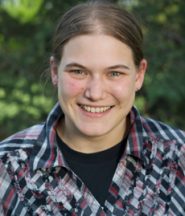An Overview
Major: Geology
Academic Affiliation: University of Wisconsin-River Falls
Biography
Ann Marie Prue is a geology major at the University Wisconsin-River Falls. She has been interested in rocks and minerals from an early age. Her dream is to become a professor of geology to help educate the next generation of geoscientists.
During her RESESS summer, Ann Marie studied the rate of soil drydown under the mentorship of Dr. Eric E. Small and his graduate student Peter Shellito, using GPS multipath satellite signals. She learned that temperature has a greater effect on soil moisture than the amount of precipitation.
Abstract
2014- Quantifying the Rate of Surface Soil Drying Following Precipitation Events Using PBO H2O Soil Moisture Time Series
Surface soil moisture affects latent and sensible heat fluxes, as well as setting the top boundary condition for water redistribution within the soil column. The fluctuations in surface soil moisture have been described in numerous modeling studies, but characterization based on measurements is lacking. We use a new soil moisture dataset based on reflected GPS signals to provide some constraints on rates of surface soil drying after a rain event.
The soil moisture time series used in this study are derived from GPS data collected at NSF’s EarthScope Plate Boundary Observatory (PBO) sites. The University of Colorado Boulder’s PBO H2O project estimates daily near-surface soil moisture (approximately 0-5 cm) from the interference pattern between the direct and ground-reflected GPS signals. The sensing footprint is ~1000 m2, and thus intermediate in scale between in situ and remotely sensed observations. Twelve sites from this network of more than 100 were used in this study.
To characterize the rate of soil drying, we fit exponential curves to daily soil moisture observations following ten isolated rainfall events at each site. Event sizes varied from 5 to 40 mm and were followed by 17 days without rain. The decay model fits the data quite well, with r2 values exceeding 0.85 in nearly all cases. For 95% of the events studied, the exponential decay constant (e-folding time) fell between 2 and 6 days. Precipitation amount is not correlated with drydown rates. Instead, the rate of soil drying is well-correlated with air temperature: the exponential constant decreases by 0.1 days per degree Celsius. We are currently investigating how other factors, such as soil type and vegetation, influence soil drying. This study highlights the utility of the PBO H2O soil moisture product. Surface soil moisture changes rapidly, and thus the dynamics of surface soil moisture cannot be accurately characterized using datasets based on less than daily measurements.
2015- A Re-Analysis of the Late Cretaceous Flora of the Two Medicine Formation in Montana Using Digital Leaf Physiognomy
Plants are directly affected by the climatic conditions in their respective environments. Leaf architectural features that are useful for climate reconstructions include leaf size, type of margins, and venation. For over one hundred years, starting with the key research of Bailey and Sinnot (1915), scientists have worked to relate these features to climate. Several key analytical methods for analyzing extant and fossilized leaves have been developed. These methods include Leaf Margin Analysis (LMA), where the percentage of entire margin leaves is correlated with Mean Annual Temperature (MAT), and Leaf Size Index (LSI), where the percentage of certain-sized species provides a general climatic description. These two methods were the standard until a new multivariate method was developed, called Digital Leaf Physiognomy (DLP); this new approach utilizes computer image editing software and algorithms to measure different leaf features and can be used to predict both temperature and precipitation (e.g., Royer et al., 2005).
This study utilizes univariate methods of LMA and Leaf area Analysis (LAA), the correlation of leaf area to precipitation, as well as the multivariate method of DLP, to reassess the paleoclimate of an Upper Cretaceous site in Montana. The specimens for this study are fossil dicotyledon (dicot), flowering-woody plants, leaves from the early Campanian Two Medicine Formation collected near Cut Bank, Montana. Twenty-eight morphotypes were described and previously studied by Crabtree (1987) to infer a megathermal (tropical) climate based off of the out dated method of LSI. In contrast Crabtree’s (1987) LMA for MAT was estimated to be 7-10 degrees Celsius with no extended cold season because of his encountering of fossil palms during excavation. Also during the time of Crabtree (1987), there was no clear method for Mean Annual Precipitation (MAP) analysis other than qualitative, which he estimated to be high and wet.
By using Digital Leaf Physiognomy and other methods, we found that Crabtree’s (1987) method of LMA yielded cooler temperatures in comparison to the DLP and univariate regression models of by Peppe et al. (2011). MAP estimates were this flora were for the first time determined using DLP. In order to evaluate the credibility of these findings, they were compared with Peppe et al.’s (2011) analysis of fossil leaves from the Fox Hills Formation. Both results suggest that DLP gives a higher and more congruent MAT than LMA. The MAP methods of DLP and LAA, were inconclusive when looking for the most credible method.

